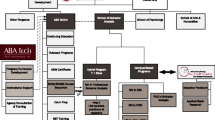Abstract
The differences within behaviorism in general and behavior analysis in particular have been described in many ways. Some of the more common distinctions are “basic versus applied”, “clinical versus non-clinical”, “behavior therapy versus behavior analysis”, and “experimental analysis of behavior versus applied behavior analysis”. These and other such distinctions do not seem to refer to truely important differences, or refer to important differences in confusing ways. It is suggested that there are two main dimensions which divide behaviorists into meaningful units: the type of paradigm (behavior analysis versus methodological behaviorism) and the level of analysis (technical, methodological, conceptual, or philosophical). By considering these two dimensions a number of issues in the field are recast. In particular, many of the differences within behavior analysis are recast into questions of the relationship between theory and technology.
Similar content being viewed by others
Reference Notes
Michael, J. The relevance of animal research. Paper presented in S. C. Hayes (Chair), “Experimental analysis and applied behavior analysis: Reconciliation or divorce?”, symposium presented at the meeting of the Midwestern Association of Behavior Analysis, Chicago, May, 1977.
Catania, A. C. Untitled discussion in S. C. Hayes (Chair), “Experimental analysis and applied behavior analysis: Reconciliation or divorce?”, symposium presented at the meeting of the Midwestern Association of Behavior Analysis, Chicago, May, 1977.
Catania, A. C. Personal communication. May 20, 1977.
Bailey, J. We used to all read JEAB, but is it still necessary? Paper presented in S. C. Hayes (Chair), “Experimental analysis and applied behavior analysis: Reconciliation or divorce?”, symposium presented at the meeting of the Midwestern Association of Behavior Analysis, Chicago, May, 1977.
Brownstein, A. Science: Try it, you’ll like it. Paper presented in S. C. Hayes (Chair), “Experimental analysis and applied behavior analysis: Reconciliation or divorce?”, symposium presented at the meeting of the Midwestern Association of Behavior Analysis, Chicago, May, 1977.
Birnbrauer, J. Social significance is in the eye of the beholder. Paper presented in S. C. Hayes (Chair), “Experimental analysis and applied behavior analysis: Reconciliation or divorce?”, symposium presented at the meeting of the Midwestern Association of Behavior Analysis, Chicago, May, 1977.
Brownstein, A., Wetherington, C. L., and Fifer, W. Pavlovian factors in operant schedules of reinforcement: I. Discrete trials fixed interval schedules. Paper presented at the meeting of the Eastern Psychological Association, Boston, April, 1977.
Goldiamond, I. Personal communication. November 8, 1977.
References
Baer, D., Wolf, M., & Risley, T. R. Some current dimensions of applied behavior analysis. Journal of Applied Behavior Analysis, 1968, 1.
Brown P. L., & Jenkins, H. M. Auto-shaping of the pigeon’s keypeck. Journal of Applied Behavior Analysis, 1968, 11, 1–8.
Day, W. F. On certain similarities between the Philosophical Investigations of Ludwig Wittgenstein and the operationism of B. F. Skinner. Journal of the Experimental Analysis of Behavior, 1969, 12, 489–506.
Franks, C. M. Behavior Therapy: Appraisal and status. New York: McGraw-Hill, 1969.
Hayes, S. C., & Barlow, D. H. The scope of behavior modification in 1977. Behavior Therapy, in press.
Herrnstein, R. J. The evolution of behaviorism. American Psychologist, 1977, 32, 593–603.
Hersen, M., & Barlow, D. H. Single case experimental designs. New York: Pergamon, 1976.
Kish, G. B. Studies of sensory reinforcement. In W. K. Honig (Ed.), Operant behavior. New York: Appleton-Century-Crofts, 1966.
Krasner, L. Behavior Therapy. Annual Review of Psychology, 1971, 22, 483–532.
Kuhn, T. S. The structure of scientific revolutions. Chicago: The University of Chicago, 1962.
Mahoney, M. J. Reflections on the cognitive-learning trend in psychotherapy. American Psychologist, 1977, 32, 5–13.
Rincover, A. Sensory extinction: A principle for treating self-stimulatory behavior in autistic and retarded children. Journal of Abnormal Child Psychology, in press.
Rincover, A., Peoples, A., & Packard, D. Using self-reinforcement and sensory extinction principles to program response generalization in psychotic children. Journal of Applied Behavior Analysis, in press.
Skinner, B. F. About behaviorism. New York: Knopf, 1974.
Author information
Authors and Affiliations
Additional information
This paper is based in part upon a paper titled “Relevant and irrelevant divisions among behaviorists: A comment on a family quarrel”, presented in S. C. Hayes (Chair), “Experimental analysis and applied behavior analysis: Reconciliation or divorce?”, symposium presented at the meeting of the Midwestern Association of Behavior Analysis, Chicago, May, 1977.
Rights and permissions
About this article
Cite this article
Hayes, S.C. Theory and Technology in Behavior Analysis. BEHAV ANALYST 1, 25–33 (1978). https://doi.org/10.1007/BF03392370
Published:
Issue Date:
DOI: https://doi.org/10.1007/BF03392370




